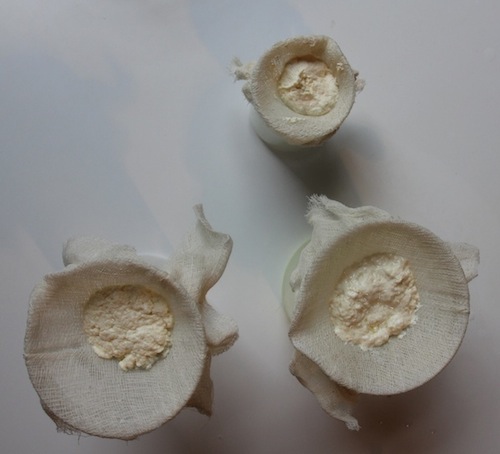When was the last time you caught a whiff of a smelly human foot? It probably wasn’t too pleasant. Perhaps it even reminded you of moldy cheese. But did it really smell that bad? There are cultural factors at play that might have influenced your reaction.
We go about our daily lives surrounded by a rich variety and an enormous number of microorganisms; yet our society strives for total antisepsis, and our culture praises the clean and antibacterial. Our milk is pasteurized, and nearly anything we purchase is plastic-wrapped and disinfected to hygienic perfection. A consequence of this hyper-sanitation could result in filtering out all smells that we don’t want. This is problematic, considering that smells and bacteria are crucial to the way in which we define, situate, and understand ourselves in relation to our environment. The intersection between smell and microbial communities is what led Christina Agapakis, a postdoctoral research fellow in synthetic biology at the University of California-Los Angeles, to explore whether knowledge and tolerance of bacterial cultures in our food improve our tolerance to the bacteria on our body and in our environment.
When Agapakis enrolled in a doctoral program to study biological and biomedical science at Harvard, she knew she was looking for a way to marry the disciplines of biology and engineering. One of her goals was to design technologies that would be useful to people beyond the lab while embracing the incorporation of a broad range of interests, methods, and concerns to synthetic biology. “Designing and developing a technology involves much more than the technical aspects of the genes and cells involved,” remarked Agapakis.
“[The] vision for the future of biotechnology is one that looks a little more like cheesemaking and a little less like computer chips, embracing rather than covering up the sometimes smelly and ‘dirty’ aspects of microbial communities in all their complexity.”
Applications in synthetic biology require the consideration of many contexts at once, some more surprising than others. These include the cell itself, the interacting genes and proteins, and the designed organism’s environment. Researchers must also consider the social, political, and economic integration contexts of their work. Since her doctoral research, which focused mostly on the cellular context of synthetic biology, Agapakis has turned to the exploration of the ecological, environmental, social, and cultural contexts – a demonstration that science is moving toward interdisciplinary integration with a greater emphasis on the big picture. “[I work] with microbiologists and ecologists, as well as artists, designers, and social scientists on research about microbial diversity and the many complex symbiotic interactions between microbial communities and between microbes and humans,” Agapakis explained.
Agapakis began the “Cheese Project” during her residency with Synthetic Aesthetics, a research program that brings together artists and scientists to explore the social and cultural aspects of synthetic biology. Agapakis paired with Sissel Tolaas, an odour researcher based in Berlin who studies how smells shape our experience of the world. As a part of her research, Tolaas creates odours we usually identify as unpleasant and try to cover up and “de-odourize”. She aims to recontextualizes these odours, challenging the spectator to reconsider their initial emotional response to “good” or “bad” smells. Through their collaboration, Agapakis and Tolaas found that many of the skin bacteria involved in producing body odour are identical to the chemicals found in cheese. ”Despite being identical, the different contexts that we find these bacteria and these smells in really shapes our experience of the smell,” noted Agapakis.
Before long, Agapakis and Tolaas began making their own cheese, using pasteurized milk supplemented with starter bacteria cultures isolated from human skin. The two researchers produced “cheese portraits”: different cheeses made from microbial samples from many different people. “These aren’t cheeses for eating, they are ‘food for thought’ to challenge some of our cultural biases about odours and about the role of bacteria in our lives,” says Agapakis. Although the future of science and technology may look sleek and encased in stainless steel, Agapakis sees it a bit differently. From her viewpoint, “[The] vision for the future of biotechnology is one that looks a little more like cheesemaking and a little less like computer chips, embracing rather than covering up the sometimes smelly and ‘dirty’ aspects of microbial communities in all their complexity.”
Agapakis’ holistic approach to science goes beyond the cultural biases associated with odours to the social issues surrounding women in science. “It was not very long ago when scientists seriously debated whether too much reading would make women infertile, presenting blatant sexism and discrimination under the banner of ‘objective’ science,” she reminded us. For her, feminist science is about recognizing cultural biases and being conscious of one’s position as a scientist and as a person. She reminds all scientists to strive for objectivity through awareness and inclusion of diverse voices in the scientific discourse.
While synthetic biology and feminism may appear quite distant from one another on the academic spectrum, Agapakis sees that the separation of arts and science hides important ideas and methods. The hope for interdisciplinary research is that it will make people increasingly aware of the role that culture, emotion, and aesthetics play in the advancement of science and technology.
* * *
Christina Agapakis will be one of the keynote speakers at this yearís Ampersand: the Conference, organized by the Bachelor of Arts and Science integrative Council (BASIC) on March 21 and 22. To see her speak, join the Ampersand McGill Facebook group and follow the link to buy your tickets ($7 for two days, $5 for one day).

